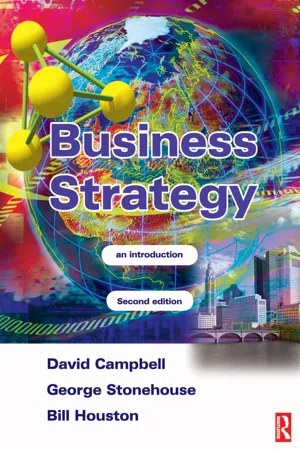Core Competencies
Core competencies refer to the unique strengths and capabilities that set a business apart from its competitors and contribute to its competitive advantage. These are the collective knowledge, expertise, and skills within an organization that enable it to deliver value to customers and outperform rivals. Identifying and leveraging core competencies is essential for strategic decision-making and sustainable business success.
8 Key excerpts on "Core Competencies"
- eBook - ePub
- Bernard Marr, Dina Gray(Authors)
- 2012(Publication Date)
- Routledge(Publisher)
...Core competence is therefore a capability, or a set of capabilities, that is linked to the strategic value proposition of an organization (see Figure 3.4). Figure 3.4 Capabilities and core competence The term ‘Core Competencies’ first became prevalent following an award winning article published in the Harvard Business Review by Gary Hamel and C. K. Prahalad. 26 Core Competencies (sometimes referred to as ‘strategic core competences’) are therefore a distinctive combination of organizational resources, such as applied technologies, skill-sets, and/or business processes, which have evolved and been learned over a period of time in response to satisfying customer (and other key stakeholder) needs. 27 They uniquely define an organization and provide a thread running through it, weaving their resources together into a coherent whole. 28 It is also the evolutionary learning process that gestates within the organization that makes it unique and, therefore, extremely difficult for competitors to replicate. Often-quoted examples of Core Competencies are Sony’s expertise in miniaturization to create ‘pocketable’ consumer products and Honda’s ability to get the best out of internal combustion engines. 29 Honda’s superior expertise in compact engine construction enabled it to build on this competence and become a major competitor to many established manufacturers of, for example, motorboat engines, lawn mowers and portable generators through its retail relationships, while continuing to sell automobiles and motorcycles through its own dealerships. Another company’s management that has built its success on its understanding of the firm’s Core Competencies is Wal-Mart, which transformed the company by building on its knowledge of ‘cross-docking’...
- eBook - ePub
- George Stonehouse, Bill Houston(Authors)
- 2003(Publication Date)
- Routledge(Publisher)
...These core competences make it possible for BMW to charge premium prices for its products. In this way, core competences are the basis of a organization's competitive advantage. Core competences and distinctive capabilities Kay (1993) presented a slightly different explanation, arguing that competitive advantage is based upon what he termed distinctive capability. Distinctive capability can develop from reputation, architecture (internal and external relationships), innovation and strategic assets. Marks & Spencer's competitive advantage can be explained in terms of its reputation for quality, its special relationships with its suppliers and its customers. Marks & Spencer has very exacting but mutually profitable relationships with the businesses who supply its products. It demands high quality at reasonable cost, and flexibility in return for large volumes of business. Its relationship with customers is based upon its reputation for good service, refunds and exchanges of goods, and high-quality products. The end result is that it has a performance that is superior to most of its high street competitors. Core competence arises from the unique and distinctive way that the organization builds, develops, integrates and deploys its resources and competences. An existing core competence can be evaluated for: customer focus – does it adequately focus on customer needs? uniqueness – can it be imitated by competitors and, if so, how easily? flexibility – can it be easily adapted if market or industry conditions change? contribution to value – to what extent does it add value to the product or service? sustainability – how long can its superiority be sustained over time? Competences, as opposed to core competences, can also be judged against these criteria in order to evaluate their potential to form the basis upon which new core competences can be built. Core competences can never be regarded as being permanent...
- eBook - ePub
Living in More Than One World
How Peter Drucker's Wisdom Can Inspire and Transform Your Life
- Bruce Rosenstein(Author)
- 2009(Publication Date)
- Berrett-Koehler Publishers(Publisher)
...TWO Developing Your Core Competencies Leadership. . .rests on Core Competencies that meld market or customer value with a special ability of the producer or supplier. 20 The concept of Core Competencies, originally developed at the organizational level, is increasingly being applied to individuals. Core Competencies—what an organization can do better than others, or abilities that provide a particular competitive advantage—have been part of the business world’s vocabulary since the phrase was introduced in the early 1990s. The term is associated with the authors Gary Hamel and C. K. Prahalad, first from their 1990 article “The Core Competencies of the Corporation” in the Harvard Business Review, and later in their book Competing for the Future. While acknowledging the contributions of these authors and the idea of core competence, Drucker traced the principle back to his own work. In his 1995 book Managing in a Time of Great Change, Drucker said that organizations required “strengths analysis” (a term he coined in his 1964 book Managing for Results) to take advantage of opportunities. In the preface to Competing for the Future, Hamel and Prahalad pay tribute to Drucker, “whose wisdom has benefited our work enormously.” 21 For our purposes, the concept of core competence can be expanded to include the development of individual excellence. Such a focus can help you carry out the kind of life that leads to the highest achievement and personal satisfaction. Applying your competencies allows you to serve yourself as well as other people and society in general. Being really good at something—providing a high-quality service or product—has to be at the core of what you do, backed by a solid set of personal values. What do you do so well that it gives you your best chance to contribute, at work and outside of it? Consider what is unique about what you do, and in what areas you excel. Some examples might be writing, communication, or selling...
- Triant G. Flouris, Sharon L. Oswald(Authors)
- 2016(Publication Date)
- Routledge(Publisher)
...They called in some competitive advantage experts to try to help them in their quest. The experts led top management through a series of group exercises and the result was that they had a bigger mess than when they started, because they could not distinguish what was core as opposed to non-core, or what was a competency as opposed to something that they just did relatively well. This example leads to an interesting observation: Core Competencies are essential to competitive advantage, but people seem to have a difficult time figuring out what is a core competency. Maybe it is because many people are looking for a tangible thing to be the core competency. Core Competencies can cover skills and processes, like engineering, production and even corporate identity. A core competency can be a combination of skills and knowledge, but it is something that is embedded in the organization, and because it exists the company is able to reach to new heights, even world class operations. How can an executive determine if his or her company has a core competence? Four key questions should be asked (see box). Let us evaluate each of these questions. Are Our Skills Truly Superior? A core competency requires the company to be the best, or nearly the best, at the chosen competence. A competence-based strategy cannot merely be grounded on a skill that is important to a business or something that customers like. The company has to be better at this competence than all others or at least the vast majority of its competitors. Questions to Ask to Determine Core Competencies : 1. Are our skills truly superior? 2. How sustainable is the superiority? 3. How much value can the competency generate in comparison to other economic levers? 4...
- eBook - ePub
Benefits Management
How to Increase the Business Value of Your IT Projects
- John Ward, Elizabeth Daniel(Authors)
- 2012(Publication Date)
- Wiley(Publisher)
...This consideration of the internal context of the organization in strategy formulation is called the ‘resource-based view’. Resources, Competences and Capabilities In considering the resource-based view of strategy, the terms ‘resources’, ‘competences’ and ‘capabilities’ are often used interchangeably. A discussion of the terms, and how they are related, is given in Box 2.1 and shown in Figure 2.1. Box 2.1 : Resources, Competences and Capabilities Resources are the assets, both tangible and intangible, that an organization owns or can access in order to pursue its chosen strategy. They may be physical, such as buildings and technology, people and finance, or intangible, such as know-how, brands, patents and customer loyalty. Resources may be categorized into two types: those that are similar to those available to competitors or easy to imitate and those that are unique to the organization. Figure 2.1: Resources, competences and capabilities (after Johnson and Scholes, 1999) Competences describe how resources are deployed through processes and structures in order to carry out the activities of the organization, such as product design, marketing, production, distribution and customer services. Managerial competences are also required in order to achieve effective linkages among these activities. It is the competences, rather than the underlying resources themselves, that are often the key to organizational performance. Competences can also be categorized into two types: those that are similar to others in the industry and those that allow the organization to outperform the competitors. The latter are often called core competences. The strategic capabilities of the organization describe the ability of the organization to meet the opportunities and threats of the external environment and are determined by the resources and competences available to the organization and how these are developed, combined and deployed...
- eBook - ePub
Business
The Ultimate Resource
- Bloomsbury Publishing(Author)
- 2011(Publication Date)
...The stronger those resources and capabilities compared to those of the competition, the bigger the advantage. However, where there’s no real differentiation, competitors can easily replicate products and services, creating a commodity market where none of the players has any specific advantage. These are examples of resources that competitors would find it difficult to replicate easily: • patents and trademarks • proprietary knowledge • customer base • corporate reputation • brand equity. However, as well as having resources, an organization must also have the capability to use them effectively and profitably. This is derived from business processes, quality procedures, organizational structures, corporate culture, recruitment and training processes, and relationships with suppliers and business partners. Together, they give an organization the capability to operate in a way that delivers success through innovation, efficiency, quality, and customer focus. These capabilities are intangible and can be even more difficult for competitors to replicate. Concentrate on Your Known Strengths Organizations use their resources and capabilities either to lower their cost structure or to differentiate themselves through superior products. They can use either strategy to position themselves against competitors. They also need to decide whether to use their strengths across the whole of their chosen market, or to focus on a specific sector where the combination of resources and capabilities gives them greatest advantage. So, an organization that doesn’t have the scale or resources to compete across the board can be extremely successful by concentrating on niche markets. Draw on the Resources of Your Partners Organizations can improve their competitive advantage by drawing on the resources of partners in their own value or supply chain...
- eBook - ePub
Commercial Due Diligence
The Key to Understanding Value in an Acquisition
- Peter Howson(Author)
- 2016(Publication Date)
- Routledge(Publisher)
...Cultural norms, therefore, are much more important than management direction. Organizational Capabilities The term ‘organizational capabilities’ refers to the target’s ability to do what it does. What we are really interested in are ‘distinctive competences’ and ‘core competences’. Core Competencies 6 make a disproportionate contribution to ultimate costumer value, or to the efficiency with which that value is delivered. Core Competencies are distinctive skills that yield competitive advantage and ideally are difficult for competitors to imitate. Distinctive competences can be defined as those things that a firm does particularly well relative to its competitors. To identify a firm’s capabilities, we need to have some basis for classifying and disaggregating its activities. The value chain analysis separates the activities of the firm into a sequential chain and distinguishes between primary activities (those involved with the transformation of inputs and interface with the customer) and support activities as shown in Figure 6.2. Figure 6.2 The value chain Disaggregating activities takes place first at the top level (for example, inbound logistics, marketing) and subsequently at finer levels. Outbound logistics may be broken down into warehousing, inventory control, packing and distribution and these can be further broken down into more specialist capabilities performed by smaller teams of resources. This hierarchy of capabilities applies in every firm. More general, broadly defined capabilities are always formed from the integration of more specialized capabilities. All activities can contribute towards competitive advantage. Certain areas may be more significant than others, although this may change over time. The value chain describes the essential activities that add value to the product or service...
- eBook - ePub
The Strategic CIO
Changing the Dynamics of the Business Enterprise
- Philip Weinzimer(Author)
- 2018(Publication Date)
- Auerbach Publications(Publisher)
...The payoff will be tremendous. Chapter Summary In this chapter, I identified the four competencies and associated skills that a strategic IT organization must focus on to succeed at working with business teams to achieve successful business outcomes. Included in the discussion are examples of strategic CIOs and their teams, which excel in the competency and apply the associated skills effectively: • Business knowledge (environment, opportunities, process centric) • Market knowledge (product knowledge, industry insight, competitive landscape) • Technology prowess (technology strategy/adaptability, organizational agility/strategic project capability) • Cross dimension (vision, leadership, communications) Business knowledge is an important competency for three important reasons. The first is that IT personnel need to understand how the business operates so they can intelligently communicate with business teams. The second is an understanding of the customer value provided as well as opportunities to provide improved customer value. The third is a process focus so IT personnel can identify the information intersects across the enterprise value chain, where value is created or can be created. Market knowledge is an important competency since IT personnel cannot effectively improve customer value without a good understanding of the company products, the industry trends, and the competitive environment. CIOs recognize that to be successful, they need to have a good understanding of the market. It is almost more important that key IT personnel who interact with the business on a daily basis have the same skills. Otherwise, the IT teams that work with business units will not effectively contribute to any discussion involving business challenges, opportunities, and potential solutions. Technology prowess is an important competency since technology is advancing at such a rapid pace. There are three major challenges CIOs face...







